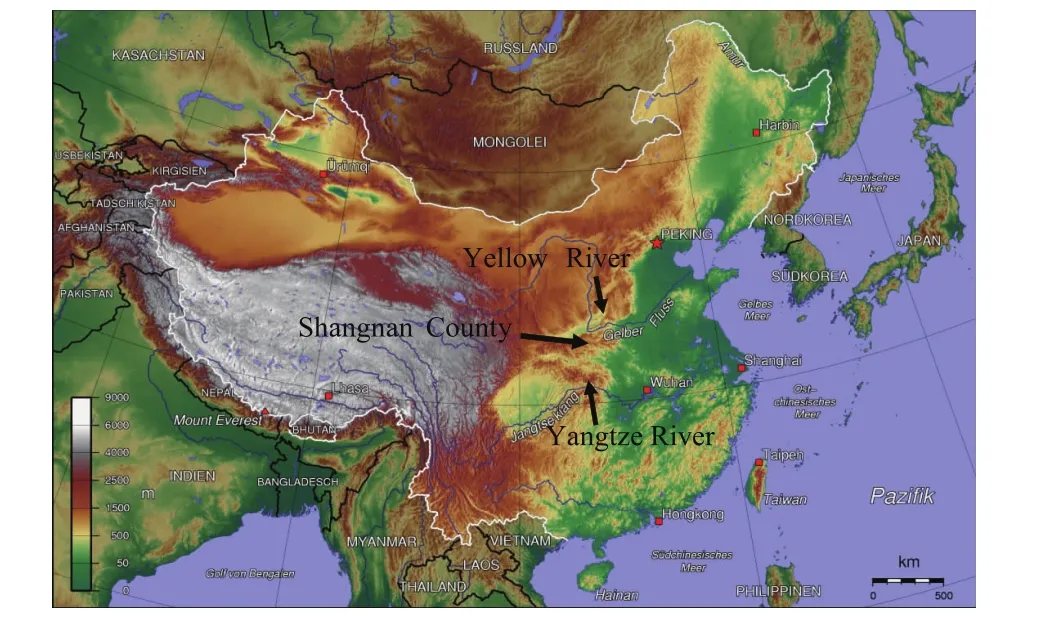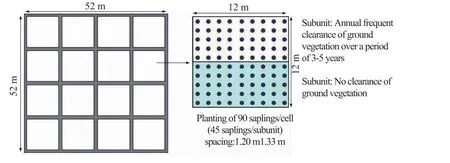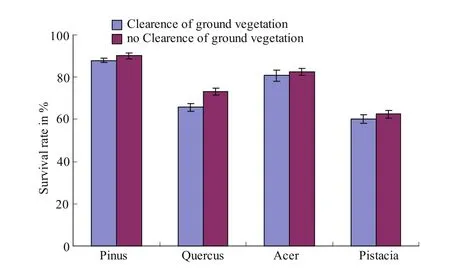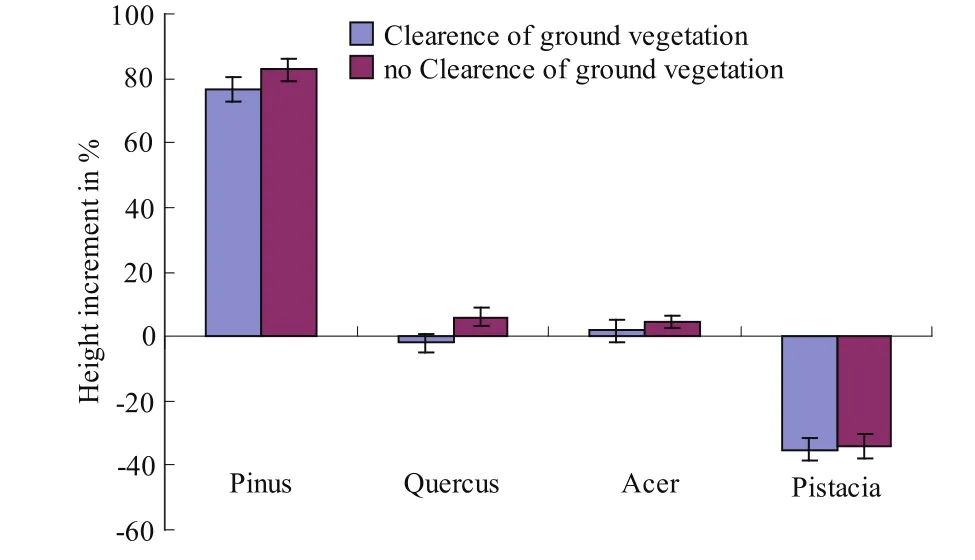Introduction to a Study on Afforestation by Native Tree Species in the Southern Shaanxi Province
Jörg Summa,Hany El Kateb,Bernhard Felbermeier,Pingcang Zhang,Reinhard M osandl(.Institute of Silviculture,TU München 80333,Germany;.Yangtze River Scientific Research Institute,Wuhan 43000,China
Introduction to a Study on Afforestation by Native Tree Species in the Southern Shaanxi Province
Jörg Summa1,Hany El Kateb1,Bernhard Felbermeier1,Pingcang Zhang2,Reinhard M osandl1
(1.Institute of Silviculture,TU München 80333,Germany;2.Yangtze River Scientific Research Institute,Wuhan 430010,China
Afforestation of abandoned agricultural lands with native tree species was undertaken in the Qinling Mountain in the South of Shaanxi Province.In a field experiment,four tree species(Chinese Red pine,Chinese Cork oak,Shandong Maple and Chinese Pistache)were studied in combination with two site cultivated techniques(with and without clearance of the competing ground vegetation).Survival and height growth increment of cultivated treeswere used in assessing the success of the first year after planting.The survival of all investigated specieswas satisfactory,while the total height developmentwas not the same for all species.Red pine was the only species that exhibited reasonable height increment due to the good quality of its initial plantingmaterial.Negligible height increment could be recorded for Maple and Cork oak.On the other hand,the Pistacia seedlings showed a decrease due to the dieback of shoots.Clearance of the competing ground vegetation had no significanteffect on the survival or height increment.Long term investigation will provide reliable information about the success/failure of the afforestation by native tree species.
afforestation;tree species;abandoned agricultural land;Qinlingmountain;Shaanxi Province
1 Introduction
Over the past50 years and in particular during the time of the economic plan“Great Leap Forward”in the 1950’s,the area of natural forests in the Qinling Mountain,which is located in the centre of the People’s Republic of China,has been greatly decreased[1,2](He et al.,2008;Leefers,2005).A large-scale deforestation was undertaken to support the agricultural and industrial modernization of the country.On one hand the cutted treesweremainly used for the production of fire wood for the industrial development,on the other hand,the fully deforested areas,were transformed into agricultural land.The long-term impacts of these activities caused severe ecological and social problems.Soils on steep slopes,which were not anymore covered or protected by the forest coverage,were vulnerable to erosion,so that they lost their fertility.An increase of the surface runoff on bare landswas another serious issue.The resultwasmassive floods along the two main rivers of China,the Yellow River and the Yangtze River(Swissre,2005).
However,many attempts were tried to reduce the rate of deforestation and its successive problems.As an example,the National Forest Protection Program(NFPP)encouraged the establishment of forest protection areas,where any kind of land use was prohibited[3](Cohen et al.,2002).Another example is the“Grain for Green Program”,which provided compensation payments to the farmers for ceasing agricultural activities on sloping lands and encouraged horticulture as an alternative land use[4](Cao et al.,2009).Such initiatives have had a positive effect on reducing erosion and stabilizing water supply[5](Bennett,2008),as abandoned farmlands developed to bush lands or secondary forests by natural succession.It is anticipated that these areaswill remain without yields in the next decades.This does not complywith the increasing demand for regenerative resources such as timber and firewood.Therefore,the transformation of abandoned lands to forest plantations becomes an enormously effective tool in attaining sustainable use of regenerative resources[6](Metzger and Hüttermann,2008).
The afforestation concepts,which have been applied for the last five decades on abandoned areas,did not consider the cultivation of native tree species,e.g.,Robinia pseudoakacia,Populus ssp.,Platycladus orientalis.Hence,most of the new afforestation areas are based on monoculture of fast growing species[7](Zhang et al,2000),which conceal a high risk for biotic or abiotic damages[8,9](Mosandl,1998;Gadgil and Bain,1999).Many studies recommend the use of site adapted tree species[10](Thomasius,1992),or themixture with native tree species to reduce the susceptible to damages[11-13](Kelty,2006;Forrester et al.,2006;Wood and Vanclay 1995).
Within the frame of a Sino-German project“Rehabilitation of degraded land ecosystems in the mountainous area of the Southern Shaanxi Province,China”①El K,H.,FELBERMEIER B,Zhang P,et al.Rehabilitation of Degraded Land Ecosystems in Southern Shaanxi Province:An Introduction to a Sino-German Project.ERSEC International conference,Beijing,China,2009.(El Kateb et al.,2009),which is a joint research project between the Institute of Silviculture at the Technische Universitaet of München,Germany and the Department of Soil and Water Conservation,Changjiang River Water Resources Commission,China,an afforestation experiment was established in 2008.The objectives of this study are(1)to assess whether native tree species can be used for afforestation of abandoned farm land,(2)to determine whether site preparation techniques,as the clearance of the competing ground vegetation,have an effect on survival and growth of the investigated species.

Fig.1 Location of the study site in the Shangnan County③http://www.waytour.ch/Geographie.asp
2 M aterials and M ethods
2.1 Study Site
The study site is located around Chang’an City(33°31′41″N;110°52′52″E)in the south-east of the Shaanxi Province,near to the border of Henan Province.It lies 600 m above sea level.The average precipitation is between 710mm·yr-1and 930mm· yr-1and the mean annual temperature varies between 7.8℃and 13.9℃②Shangluo(shaanxi)City Information.http://www.hktdc.com/info/vp/a/wr/en/2/2/1/1X06B5AB/China-Western-Region/Shangluo--Shaanxi--City-Information.htm.2009.(Shangluo City Information,2009).Most of the rainfall events occur during from May to September.The south of the Shaanxi Province ismainly dominated by the Qinling Mountain range,which extends1,500 km from the borders of Gansu and Qinghai provinces in the west to the middle of the Henan Province in the east.The Qinling Mountain represents a natural border between the dry temperate climate in the north and the humid subtropical climate in the south.In addition,the Qinling Mountain range forms an important boundary between two of China's largestwatersheds,the Yangtze and the Yellow River Watersheds.Fig.1 shows the location of the study site in the Shangnan County.
Because of the morphological and climate conditions,the Qinling Mountains are a hot spot of biodiversity and natural resources④Li,J.Assessmentof conservation of Qinlingmountains natural reserves network-the example ofgiantpanda nature reservesnetwork.Second Sino-German Workshop on Biodiversity Conservation-Management of Ecosystems and Protected Areas:Facing Climate Change and Land Use,Bonn,2009.[14](Li,2009;Tang,et al,2006).With the implementation of the“South-to-North Water Transfer Project”(Yang and Zehnder,2005)for supplying water from the humid south to the dry north of the country,the southern part of the Shaanxi Province became themost important region for providing water to the North.Near to Shangnan,the Danjiangkou Reservoir is located.It is themain reservoir for providing water for the middle route of theSouth to North Water Transfer Project[15](Yang and Zehnder,2005).Therefore,rehabilitation of degraded land ecosystems by restoring the natural vegetation cover and optimising the land use has high priority in this region,notonly for the regional but also for the national interest.
2.2 Layout of the experiment
The experiment was established in September 2008 on former agricultural lands covered by grass.Three areas in the Shangnan County were selected for the installation of the research blocks(Table 1).The site conditions of these areas were poor,because of a thin soil layer and a hillside location,which tend to drought.

Table 1 Location and some site factors of the three afforestation blocks
On each area,a block was laid out.The underlying statistical design was a 4×4 Latin Square.So,a block includes 16 cells.The blocks were used for planting four native tree species of economical and ecological importances,i.e.Chinese Red pine(Pinus tabuliformis),Chinese Cork oak(Quercus variabilis),Shandong Maple(Acer truncatum)and Chinese Pistache(Pistacia chinensis).Each cell was subdivided into two subunits.Each subunit randomly received one of two levels of a site preparation technique related to reduction of the competitive impact of the ground vegetation:(1)no clearance of ground vegetation or(2)annual clearance of ground vegetation over a period of 3-5 years.The subunit treatmentswere arranged in a split-plot design(Fig.2).The blocks of the afforestation experimentwere permanently installed and can be used for furthermedium or long-term investigations.
In each cell,90 individuals(corresponding to 6,250 individuals ha-2)were planted in October 2008.The reason for this high initial density is that a part of the saplings is foreseen to be collected for biomass and root investigations.Planting was arranged in rows and columns,so in one subunit there were five rows and nine columns.The size of one cell is 12 m× 12 m,resulting in a total planted area of 6,912 m2(3 blocks×16 cells×144 m2).
2.3 Planting material
The four native tree species(Table 2)were obtained from two different nurseries.One is located in Chang’an in the Shaanxi Province,a county near Xi'an,which is around 200 km far from Shangnan.The other is in Songxian,which is around 130 km far from the study area and is located in the neighbouring Province Henan.Chinese Red pine and Shandong Maple were obtained from the first nursery,while Chinese Cork oak and Chinese Pistache from the second.Chinese Red pine and Chinese Cork oak were container saplings.Shandong Maple and Chinese Pistache were bare root saplings and the rootswere strongly cut.The age of the seedlings was one year old for Chinese Red pine and Chinese Pistache,and 2 years old for Chinese Cork Oak and Shandong Maple.Therewas no information available about the provenance of the trees,as systems for forest reproductive materials do not exist in China.

Fig.2 Layout of the 4×4 Latin Square in an afforestation block

Table 2 Some information about the planting material
Prior to planting,60 saplings of each tree species were randomly selected for the assessment of the quality of the plantingmaterial.
信念是指对某一事物坚定的看法,它反映了一个人随时为实现一定的思想和原则而斗争的准备[12]。教育信念是教师个体所确信的,能够对其教育教学行为起到直接和间接支配作用的相互关联,相互支持的价值判断系统[13]。在教育教学实践中,教育信念能够使教师始终保持正确的教育理念和执行规范的教育行为,让其在思想和行为上遵循自己所信奉的教育原则。拥有坚定教育信念的教师通常坚信某种教育原则或模式,并将其内化为个人信念,落实在自己的实践教学中。
2.4 Data Collection
A listof the recorded data is indicated in Table 3.
3 Results
The assessmentof the quality of the plantingmate-rial was based on 60 randomly selected saplings from the initial planting-material of each tree species.For all tree species,the coefficient of variation for all parameters indicated in Fig.3 was relatively low(Fig.3),implying that the plantingmaterial was rather homogenous.The planting material of the Chinese pistache showed the highest variability in total height.Chinese Red pine had the lowest total height and a relatively high root length and,thus,the highest rootlength total-height ratio(Fig.3).This gives an indication that the plantingmaterial of the Red pine,in comparison to the other species,had a better quality.

Table 3 List of the collected data

Fig.3 Arithmetic mean of the total height,root collar diameter,root length,and root-length total-height ratio of the initial planting material(figures above bars indicate the coefficient of variation)
One year after planting,the Pinus showed high survival rate of nearly 90%,the Acer had also high survival of over 80%(Fig.4).The survival of the Quercuswith nearly 70%was still satisfying.The Pistacia had the lowest survival rate of 60%.
The Pinus showed a reasonable height increment after the first growing season(Fig.5).The average increase was around 80%of the initial height.One year after planting,The Quercus and Acer had nearly no height increment.Pistacia saplings showed a decrease in height of approximately 35%of its initial height due to draught associated with dieback of the previous year shoots.
The frequent clearance of ground vegetation hadno significant effect on survival and growth.However,with no exception,slightly better resultswere indicated in the subunits with no clearance of ground vegetation than thosewith frequent clearance(Fig.4 and Fig.5).

Fig.4 Survival rate after the first grow ing season

Fig.5 Height increment,one year after planting
4 Conclusion
Themost practical result of the short-term observation of one year is that native tree species can be used for the afforestation of abandoned farmlands.The four native species showed satisfying survival rates under the given poor site-conditions.However,the first year height-growth of the broadleaf species was disturbed.The short-term observation of one year does not give clear picturewhether this disturbance is due to the transplant shock,provenance of the trees,low quality of the planting material,or the poor site conditions.Compared with the broadleaf species,the Pinus with the good-quality seedling materials showed reasonable growth at the early stage under the given site conditions.
Due to the short observation period of one year,valid information about the impact of the clearance of the ground vegetation can not be made.However,there is an indication that during the implementation the treated saplings were damaged or cut.For an appropriate assessment of the success or failure of the afforestation and the effectiveness of the treatments,a longer observation period is required.This is foreseen to be undertaken within the frame of the project.
Acknowledgements Grateful acknowledgment is provided to the German Federal Ministry of Education and Research for funding the project(FKZ 0330803),and to the Department of Soil and Water Conservation,Changjiang River Water Resources Commission for the financial contribution to support the establishment of the research and work in the study area.
REFERENCES:
[1] HE F,GEQ,DAIJ,et al.Forest change of China in recent 300 years[J].Journal of Geographical Sciences,2008,18(1):59-72.
[2] LEEFERSK.The impacts of the National Forest Protection Program on rural livelihoods in Yunnan,China[R].East Lansing:Michigan State University,2005.
[3] COHEN D H,LEE L,VERTINSKY I.China’s Natural Forest Protection Program(NFPP):Impact on trade policies regarding wood.http://www.forestry.ubc.ca/cbom/articles/chinasnaturalforestprotection.pdf.2002.
[4] CAO S,CHEN L,YU X.Impact of China's Grain for Green Project on the landscape of vulnerable arid and semi-arid agricultural regions:a case study in northern Shaanxi Province[J].Journal of Applied Ecology,2009,46(3):536-543.
[5] BENNETTM T.China’s sloping land conversion program:Institutional innovation or business as usual[J].Ecological Economics,2008,65:699-711.
[6] METZGER JO,HüTTERMANN A.Sustainable global energy supply based on lignocellulosic biomass from afforestation of degraded areas[J].Naturwissenschaften,2008,96:279-288.
[7] ZHANG P,SHAO G,ZHAO G,et al.China’s Forest Policy for the 21st Century[J].Science,2000,288:2135-2436.
[8] MOSANDL R.A new objective ofmanagement:the close to nature forest[R].Forstliche Schriftenreihe:Universität für Bodenkultur Wien 12,1998.
[9] GADGIL PD,BAIN J.Vulnerability of planted forests to biotic and abiotic disturbances[J].New Forests,1999,17:227-238.
[10]THOMASIUS H.Prinzipien einesökologisch orientierten Waldbaus[J].Forstwissenschaftliches Zentralblatt,1992,111:141-155.
[11]KELTY M J.The role of speciesmixtures in plantation forestry[J].Forest Ecology and Management,2006,233(2-3):195-204.
[12]FORRESTER D I,BAUHUSJ,COWIEA L,etal.Mixedspecies plantations of Eucalyptus with nitrogen-fixing trees:A review[J].Forest Ecology and Management,2006,233(2-3):211-233.
[13]WOOD P J,VANCLAY J K.Papers from the IUFRO Tropical Silvicultural Subject Group[J].Commonwealth Forestry Review,1995,74(4):281-343.
[14]TANG Z,WANG Z,ZHENG C,etal.Biodiversity in China’smountains[J].Frontiers in Ecology and the Environment,2006,4(7):347-352.
[15]YANG H,ZEHNDER A J B.The South-North Water Transfer Project in China-an analysis of water demand uncertainty and environmental objective in decision making[J].Water International,2005,30(3):1-11.
(Edited by LIU Yun-feiand YIXin-hua)
S72 Document code:A
1001-5485(2010)11-0075-06
date:2010-10-11
Jörg Summa,male,Germany.His interest is forestry,(E-mail)joerg.summa@web.de

